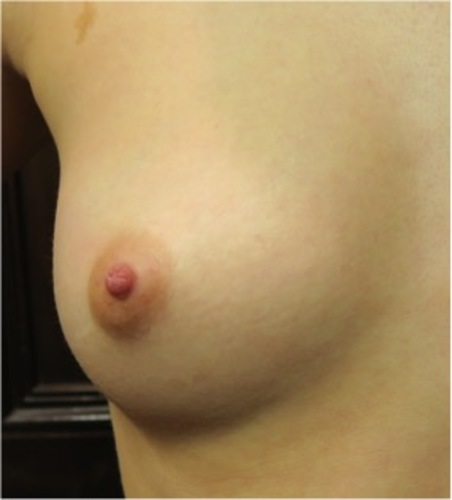In search of the perfect nipple: the rise of the “nip” tuck Surgeons see a 30% rise in women requesting a smaller nipple size as cup sizes plummet from DD to C
For Immediate Release
For media enquiries contact:
Lynne Thomas lynne@flipsidepr.co.uk
Flipside PR - 020 7631 5180
www.theplasticsurgerygroup.co.uk
Bigger is not always better, not when it comes to nipples anyway, that’s according to new research by The Plastic Surgery Group.
Breast surgery has long been one of the most popular plastic surgery procedures but while we all have ideas about what constitutes the perfect breast shape, what about the perfect nipple size?
A survey conducted by The Plastic Surgery Group has shown that there is a new trend towards patients choosing smaller nipple sizes when undergoing breast surgery.
The group, which was founded by a collective of expert surgeons who are all full members of the British Association of Aesthetic Surgeons and the British Association of Plastic Reconstructive and Aesthetic Surgeons, has noticed a recent shift in patient requests around nipple aesthetics.
Consultant plastic surgeon Dan Marsh explains, “During breast surgery to lift or reduce the breast the nipple is repositioned. This requires an incision around the nipple and gives the patient an opportunity to resize her nipple. We have always asked our patients to choose the size of their nipple during surgery rather than using a standard template.
“We have seen a 30% rise in women requesting a smaller nipple size in the last year. This is tied into the trend towards smaller breast augmentation sizes. The average size is now 250-300cc (approx D-C cup) compared with 350-400cc (Double DD or E cup) several years ago.”
To study this further The Plastic Surgery Group put together a selection of photographs of breasts and nipples to see if they could ascertain what people thought was the ideal nipple size and if there were any trends.
131 people took part and were asked to rate the nipples from one to five in order of attractiveness and to say whether they felt the diameter of the nipple areola complexes shown were “too big”, “too small” or “just right”.
Commenting on the results, Consultant Plastic Surgeon Mo Akhavani said, “We found that patients with smaller sized nipples rated higher in attractiveness than those with larger nipples.”
The nipples most consistently rated as the most attractive and as “just right” in size had a nipple that occupied 25-30% of the breast when the breast is viewed from straight on.
If a nipple size was more than 50% of the breast in the same view, then 92% of respondents rated the nipple as “too big”. 78% of respondents felt that if the nipple areolar complex was less than 15% of the breast width the nipple was “too small”.*
One reason for this may be that disproportionately big areolas/nipples are associated with large, saggy breasts, or with conditions such as tuberous breasts. Pregnancy and breastfeeding can also contribute to the formation of overly large areolas and as such smaller nipples may be associated with youth and pre-pregnancy bodies.
“This study is of benefit to patients considering breast lift or breast reduction surgery as they should discuss the size of their new nipple areolar complex with their surgeon”, Akhavani comments. “The traditional surgical teaching and marking for breast surgery uses standard nipple markers which are fixed in size – typically at 46mm in diameter.
“Clearly the results of our survey demonstrate thay a single nipple size is not appropriate for all women and the nipple diameter should be adjusted so that it is 25-30% of the breast width. There is also a modern trend towards smaller nipples.”
Nipples have traditionally been a taboo subject when speaking about breasts, something that is covered up and hidden away, but with celebrities like Miley Cyrus, Cara Delevingne and Naomi Campbell being vocal about “freeing the nipple” on social media and trends emerging around what women’s nipple preferences are, we may be seeing a shift in attitudes and a new era of “nip tuck”.
About The Plastic Surgery Group
The Plastic Surgery Group was set up as an alternative to the other large commercial cosmetic surgery providers. They offer an individually tailored experience provided by, and only by, the founding surgeons who are on the specialist register for Plastic Surgery and are full members of the British Association of Aesthetic Surgeons and the British Association of Plastic Reconstructive and Aesthetic Surgeons.
Daniel Marsh is an award winning breast and facial surgeon, who has carried out thousands of plastic surgical procedures, specialising in producing a natural look.
Mo Akavani is a meticulous body contouring and facial surgeon. Mo combines academic excellence with surgical finesse to achieve optimum results.
Lucian Ion is an expert rhinoplasty and facial surgeon. Internationally recognised particularly for revisional rhinoplasty surgeries.
*IMAGES AVAILABLE UPON REQUEST
This press release was distributed by ResponseSource Press Release Wire on behalf of Flipside PR in the following categories: Health, Women's Interest & Beauty, for more information visit https://pressreleasewire.responsesource.com/about.
